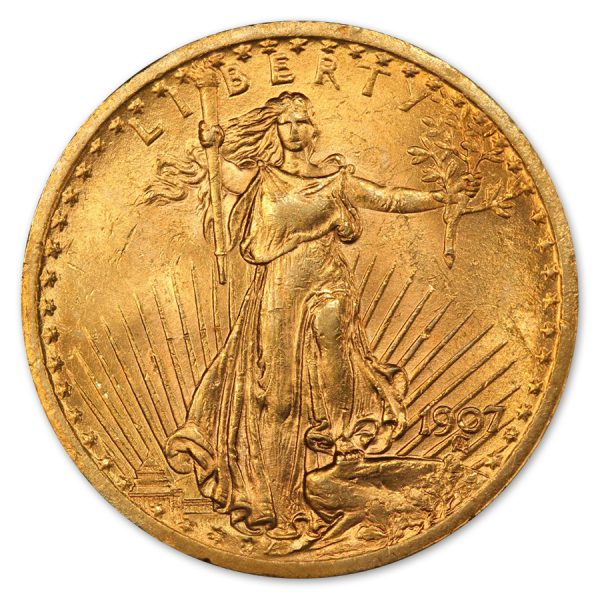Liberty 20 Double Eagles
Learn More About Liberty 20 Double Eagles

Liberty $20 Double Eagle gold coins were minted from 1850 until 1907 and played a vital role in the U.S. economy during the 19th century. Due to the high gold content, these coins were used primarily in international trade and as savings vehicle for the wealthy.
Although many coins were melted during the gold confiscation in 1933, many coins were hoarded for decades in European vaults.
Liberty Double Eagle Design
The obverse of the Liberty Double Eagle features a left-facing portrait of Lady Liberty, wearing a coronet inscribed with the word "LIBERTY." This design is emblematic of the neoclassical style.
The reverse showcases a majestic bald eagle, holding arrows and an olive branch, symbolizing military strength and peace. Above the eagle's head are 13 stars, representing the original colonies, and a banner inscribed with "E PLURIBUS UNUM" ("Out of many, one").
The denomination is shown as "TWENTY D." on the reverse until 1877 when it was changed to read "TWENTY DOLLARS."
The coin's composition is 90% gold and 10% copper, weighing approximately 33.436 grams and containing .9675 troy ounces of pure gold.
Bullion Liberty Double Eagles
A bullion-grade Liberty $20 Double Eagle is a common-date coin that derives its value from gold content rather than rarity or condition.
Bullion quality Double Eagles are commonly found in About Uncirculated (AU) to Mint State 62 (MS62) condition, making them attractive to gold investors who want historic U.S. gold coins cheaper than rare numismatic pieces.
Their value is primarily tied to the gold spot price, with a slight premium added for their collectibility and historical significance.
Many investors prefer bullion-grade Liberty $20 Double Eagle coins over modern bullion because they are widely recognized, highly liquid, and offer a tangible connection to America’s gold standard era.
They can be easily bought and sold through bullion dealers, coin shops, and online marketplaces, making them a practical option for those who want to own physical gold in a classic and highly respected form.
Certified $20 Double Eagles
Certified Liberty $20 Double Eagles are authenticated and graded by professional third-party grading services such as PCGS, NGC or ANACS.
The certification process ensures the coin's authenticity, grade, and preservation as well as providing an extra layer of assurance for investors that the coin is authentic and correctly graded.
Certified Double Eagles have undergone a rigorous authentication process to ensure they are genuine and not counterfeits.
Once graded, they are encapsulated in a protective holder to prevent damage and maintain their certified grade.
Many investors view certified Liberty Double Eagles as a reliable investment due to their historical significance, gold content, and numismatic value.
Certified coins are easier to sell due to their established grade and authenticity, providing greater liquidity than raw or uncertified coins.
Liberty $20 Double Eagle Investment
Each Double Eagle Gold coin was minted with .9675 troy ounces of 21.6k gold, or .900 purity.
A small amount of copper was added to provide strength for circulation. As a tangible investment, Pre-1933 gold coins are highly liquid. The market for these coins spans both investors and collectors.
Millions of Liberty $20 gold coins were melted down after 1933 when the U.S. government recalled gold. The ones that have survived, carry some numismatic premium due to their rarity, especially those in higher grades or with specific mint marks or low mintage years.
California Gold Rush
The sudden influx of gold from California Gold Rush dramatically increased the nation's gold supply. Prior to this period, the largest denomination gold coins in circulation was the $10 Eagle, but the vast amount of new gold created such a surplus that a larger denomination was warranted to handle high-value transactions more efficiently.
To meet the growing demand, Congress passed the Coinage Act of 1849, which authorized the creation of the $20 Double Eagle. The first pattern for the coin was struck in 1849, and production for circulation began in 1850.











